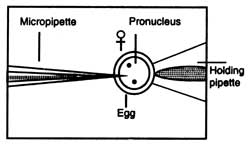
- •5)The principles of genetic cloning
- •11)The principles and methods of plant cells cultivation in vitro
- •II) Shake Culture:
- •III) Spinning Culture:
- •IV) Stirred Culture:
- •I) Chemostats:
- •II) Turbostats:
- •29)Cell reconstruction. Theoretical means of cell reconstruction
- •35)The history of investigations of the genetic transformation of animal cells
- •Plants for bio-energy
- •53)Genetic engineering. Methods of genetic transformation
- •Commercial Applications
- •Application to Human Disease and Research
53)Genetic engineering. Methods of genetic transformation
Genetic engineering, also called genetic modification, is the direct manipulation of an organism's genome using biotechnology. (Indirect genetic modification through artificial selection has been practiced for centuries.) New DNA may be inserted in the host genome by first isolating and copying the genetic material of interest using molecular cloning methods to generate a DNA sequence, or by synthesizing the DNA, and then inserting this construct into the host organism. Genes may be removed, or "knocked out", using a nuclease. Gene targeting is a different technique that uses homologous recombinationto change an endogenous gene, and can be used to delete a gene, remove exons, add a gene, or introduce point mutations.
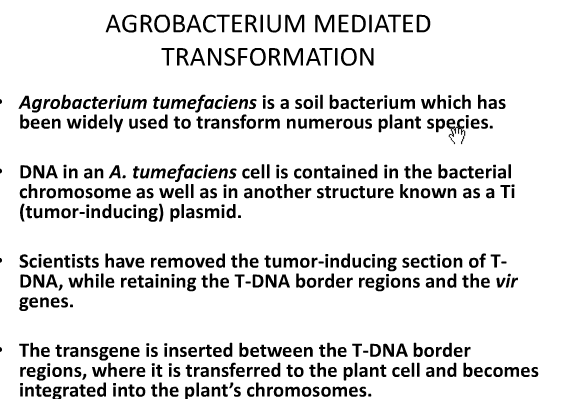

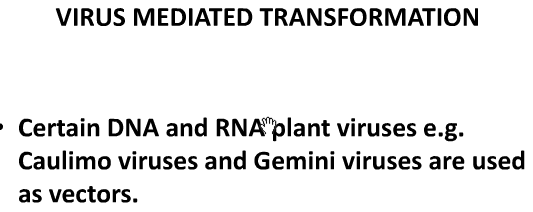


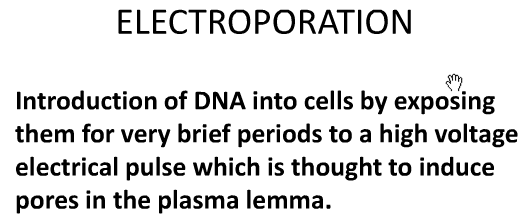
 59)Cryopreservation
of plant cell and tissue
Cryopreservation
- freezing at very low temperatures. Usually it is carried out in
liquid nitrogen at-196oC.
59)Cryopreservation
of plant cell and tissue
Cryopreservation
- freezing at very low temperatures. Usually it is carried out in
liquid nitrogen at-196oC.
Freezing Plant cells from animals differs mainly presence preculture stage.
Cryoprotectants - substances that reduce the damaging effects of physical and chemical factors in cryopreservation. These include sucrose, dextran, ethylene glycol, polyvinyl pyrrolidone, dimethylsulfoxide (DMSO), glycerol. To determine the toxicity of the cryoprotectant cell was kept at room temperature in its various concentrations for 30 - 50 minutes, then determine their viability.
Typically, cooling is carried out in two phases (Fig. 26):
Stage 1: from-28oC to +20 at a rate of 1 degree per minute (plant cell freezing rate of 0.5 degrees per minute to -35 ° C), maintained at this temperature for 15 minutes.
2nd stage: immersion in liquid nitrogen (instantaneous cooling to - 196oC).
Freezing produced in special vehicles. In their absence, - an alcohol bath (0.5 - 1 liter alcohol is poured into the metal thermos flask was immersed in it for 15 minutes vial was added with stirring and liquid nitrogen or dry ice, the temperature is brought to-32oC (temperature should not exceed -28 or below-32C.) Next transferred into liquid nitrogen ampoule.
When thawing ampules forceps transferred into a water bath at 37 - 40 ° C, an ampoule of 1 mL were thawed for 0.5 - 1 minutes.
After thawing, the cells were washed in either growth medium (animal) or supportive environment. Plant cells can also be laundered 3 - 10% sucrose solution.
The cells were checked for viability using the vital dye staining dead cells. The final criterion is a clear return to growth on standard culture media used for the culture.
Immortalized mammalian cells after thawing have an increased susceptibility to viruses, which manifests itself in the first two passages. Next, the sensitivity of returns to the original.
The slowdown
Slowdown can be achieved by the following methods:
1. Storage under a layer of mineral oil (for fungal and bacterial cultures).
2. Change in gas composition and atmospheric pressure inside the culture vessel.
3. Changing light conditions.
4. Cooling stop temperature to active growth.
5. Hormonal and osmotic inhibitors. From hormonal inhibitors most often used hlorholinhlorida (for plant cells) of osmotic - mannitol in a concentration of 3-6%.
6. Replacement of CaCl2 to Ca (NO3) 2 in the culture media.
For the potato as a method allowing to keep the gene pool, it is recommended nodulation in test tubes.
65 |
)Methods of embryo transplantation |
|
|
|
|
Embryo is now one of the most pressing issues in the field of animal farming. With the help of embryo transfer can dramatically increase the yield of the progeny of high-producing cows. Embryo or embriotechnology is to obtain one or more embryos from the uterus of breeding animals (donors) and transplant the uterus of cows (retsepient), where embryos develop to calving. This method, combined with superovulation in donors can get a great seed of high yielding animals. In this way the embryos can be implemented in either breed in other regions, using as retsepient beef cows. This method also facilitates the exchange of agricultural gene pool of animals between countries and continents. Embryo transfer can be used to produce offspring from valuable, but barren cows that have lost the ability to grow as a result of accident, illness or age.
When it was established that the rabbit has immunity against FMD, put forward the idea of using the method for the recovery of transplant pups of foot and mouth disease of animals. Genital tract of the rabbit, which transplanted embryos can destroy FMD virus in embryos. Transplantation can be used for temporary storage of embryos. In the oviducts of rabbits can carry transcontinental transport of sheep embryos.
Removing the embryos until the 70s produced mainly by surgery, he was subsequently replaced by a less traumatic and time-consuming non-surgical, based on the introduction of a special probe into the uterus through the natural channel. The probe has three channels. One channel is for inflating the balloon that occludes the uterine horn, preventing leakage of fluid. According to another input channel saline at 25-30C, and the embryos are washed back with them through the third channel of the probe into the tube placed in a waterbath at 35C. From this liquid extracted embryos. On average superovulation of donor can be from 5 to 7 embryos.
Transplantation is carried out with the help of a special probe or a gun for insemination. Embryos were placed in the uterine horn. Pregnancy in females - retsepient checked on the level of progesterone in plasma on day 21.
Regulation of sex. In the practice of breeding animals is very important to learn to manage education in the offspring of male and female individuals. The method of separation of embryos by sex based on determining specific proteins males. This method is widely used in animal practice in many countries. In Canada since 1975 born calves, separated by sex on stage embryos. In the long term to get targeted individuals, male or female can be used microsurgical technique replace the X and Y chromosomes. Such manipulations are carried out on the plant cells and amphibian oocytes.
71 |
)Describe the method of microinjection of DNA in the germ cells of animals |
Microinjection is an effective method for creating transgenic animals, for RNAi of selected genes, and for introducing various types of molecules directly to cells. For DNA transformation, the easiest approach is to inject DNAs into the distal arm of the gonad. The distal germ line of C. elegans contains a central core of cytoplasm that is shared by many germ cell nuclei .Therefore, DNAs injected here can be delivered to many progeny. This approach usually leads to the formation of large extrachromosomal DNA arrays . Microinjection directly into oocyte nuclei can induce chromosomal integration of transgenes, but this technique is relatively difficult to do . For RNAi experiments, most progeny of injected animals can be affected by simply injecting dsRNA into a single gonad or intestinal cell because of a very efficient RNA transport system . While RNAi by feeding is best for high throughput experiments, RNAi by microinjection is more effective for at least some genes .
Microinjection Microinjection is a technique of delivering foreign DNA into a living cell (a cell, egg, oocyte, embryos of animals) through a glass micropipette. One end of a glass micropipette is heated until the glass becomes somewhat liquified. It is quickly stretched which forms a very fine tip at the heated end. The tip of the pipette attains to about 0.5 mm diameter which resembles an injection needle. The process of delivering foreign DNA is done under a powerful microscope. Cells to be microinjected are placed in a container (Fig. 4.15). A holding pipette is placed in the field of view of the microscope. The holding pipette holds a target cell at the tip when gently sucked. The tip of the micropipette is injected through the membrane of the cell. Contents of the needle are delivered into the cytoplasm and the empty needle is taken out.
|
|
|
|
Fig. 4.15. A method of microinjection of DNA preparation in egg. |
|
Xenopus oocytes have been widely used for the study of transcription by microinjection because oocytes contain between 6,000 and 100,000 or more RNA polymerase molecules than somatic cells. Microinjection is technically easy because of large size of oocytes. Some of the endogenous pattern of gene regulation during development has been characterized (Wickens and Laskey, 1981). The injected DNA integrates randomly with nuclear DNA and its expression could be possible only when the foreign DNA is attached to a suitable promoter sequence.
77 |
)Methods for determining the viability of eggs, sperm and embryos |
77)Methods for determining the viability of eggs, sperm and embryos The method for determining the viability of embryos relates to agriculture and can be used for embryo transfer in farm animals. The invention consists in that the embryo quality assessed twice: before freezing, then after freezing and thawing and by comparing the results of these evaluations is determined embryo viability. To carry viable embryos that have not changed their evaluation process of cryopreservation. The method improves the accuracy of determining the viability of embryos during freezing and in the degree of change in the quality of their results to predict engraftment after non-surgical transplantation. The method also allows the use of embryos rating 3 points to freeze. There are methods for assessing the quality of embryos in vitro, which involve the use of dyes that detect enzyme activity (fluorescein diacetate) (2) or a special label that defines membrane damage in a defective condition of embryonic cells (3). However, these methods are not without drawbacks, as the additional manipulation of embryos during their assessments can cause the reduction or complete loss of their ability to further development, in addition, they require additional costs for reagents and efforts of experts. Closer to the present invention is a method of temporary embryo culture in vitro in the laboratory to refine the quality assessment based on morphological criteria (1). Work to assess the embryo is performed under a stereo microscope with a magnification of 60-80 times, given the stage of embryo development, compliance with its chronological age, determine the morphology of embryos and, on the basis of these criteria, assess the quality of the embryo and its suitability for further use. There were and there are many misconceptions about the speed of movement and life span of sperm. Now we know that the time during which the spermatozoa retain their mobility, as well as the period of their ability oplototvoryayuschey much shorter than previously thought. Preservation of sperm motility was seen as an indicator of fertility. Now we know that mobility continues for much longer than the ability to fertilize. The rabbit, for example, found experimentally that the sperm lose the ability to fertilize after about tridtsatichasovogo stay in the female genital tract, while their mobility continues up to two days. Unfortunately, similar data on human sperm is not as accurate. It is believed that their fertilizing capacity is maintained for 1-2 days, and mobility, apparently, 2 times longer. The method developed by scientists an opportunity to assess the viability of the embryo, is based on the observation of the movements taking place in the egg immediately after fertilization. At this point, the nature and rate of pulsation of the cytoplasm, scientists can determine the possible viability of the fetus. These conclusions are based on the observations of experts for bulges and protrusions on the surface of a fertilized egg, which appear and disappear in the process of ripple cytoplasm. These characteristic movements going on about four hours associated with activation of actin and myosin cytoskeleton. Fluctuations in the concentration of calcium ions that accompany the process of fertilization, cause changes in the structure of the cytoskeleton. The speed and nature of such movements suggest how to viable embryo. The results of these studies have great value, especially for in vitro fertilization (IVF), in which fusion of gametes carried out "in vitro", after which the fertilized egg is implanted future mother. This process, in vitro fertilization, is not always succeeds, doctors sometimes have to implant several fertilized eggs, and the status of the embryo assessed by analyzing the cells of the embryo.
83 |
)Production of beer and other alcoholic beverages |
Brewing is the production of beer through steeping a starch source (commonly cereal grains) in water and then fermenting with yeast. Brewing hastaken place since around the 6th millennium BC, and archaeological evidence suggests that this technique was used in ancient Egypt. Descriptions of various beer recipes can be found in Sumerian writings, some of the oldest known writing of any sort.[1][2][3] Brewing is done in a brewery by a brewer, and the brewing industry is part of most western economies.
The basic ingredients of beer are water; a starch source, such as malted barley, which is able to be fermented (converted into alcohol); a brewer's yeastto produce the fermentation; and a flavouring, such as hops. A secondary starch source (an adjunct) may be used, such as maize (corn), rice or sugar. There are several steps in the brewing process, which include malting, milling, mashing, lautering, boiling, fermenting, conditioning, filtering, andpackaging. There are three main fermentation methods, warm, cool and wild or spontaneous. Fermentation may take place in open or closed vessels. There may be a secondary fermentation that can take place in the brewery, in the cask, or in the bottle.
Brewing specifically includes the process of steeping, such as with making tea, sake, and soy sauce.
Wine production
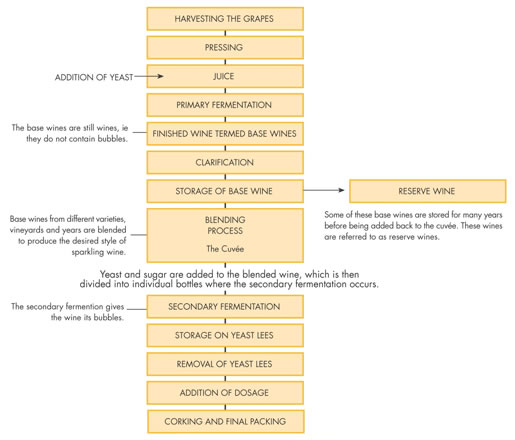
89)Yeasts,their application Yeasts are eukaryotic microorganisms classified in the kingdom Fungi, with 1,500 species currently described (estimated to be 1% of all fungal species). Yeasts are unicellular, although some species with yeast forms may become multicellular through the formation of a string of connected budding cells known as pseudohyphae, or false hyphae, as seen in most molds. Most yeasts reproduce asexually by mitosis, and many do so by an asymmetric division process called budding.
By fermentation, the yeast species Saccharomyces cerevisiae converts carbohydrates to carbon dioxide and alcohols – for thousands of years the carbon dioxide has been used in baking and the alcohol in alcoholic beverages.

